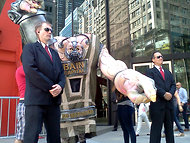I run a management consulting firm, and one of our clients found herself in that situation. As a senior leader in a large organization, she found that her days were filled with back-to-back meetings and conference calls. Because her direct reports were unlikely to find her at her desk for very long, they started following her into the restroom, file folders in hand, to get answers to their many questions. (Actually, of course, only the women could do that. The men waited for her outside the door.)
Like my client, a majority of executives spend a significant percentage of their workdays in meetings. And the higher their rank, the worse the situation. Top executives bear the brunt of the burden, but our meeting-intensive culture affects employees at all levels. Just look around your office. Where is everybody?
The meeting culture that is dominating corporate America is unsustainable and unproductive. How many meetings did you attend last week that didn’t even have an agenda? How many resulted in a new idea? And at how many meetings did you think, “Why am I even here?”
Time is a commodity. And time spent in a meeting should generate a return on investment. But how often do we think about our time that way, and set expectations for meetings to produce real returns? In my experience working with Fortune 500 companies, the answer is rarely. This is just one result of a meeting-intensive culture.
It’s time for a meeting revolution. Instead of automatically accepting that next meeting request, pause and consider your return on investment. Will this meeting help you in achieving your goals? How does the purpose of the meeting — and I’m crossing my fingers that there is a stated purpose — align with the company’s strategic priorities? Is attending this meeting the best use of your time right now? If not, revolt — by declining the meeting request.
By declining, you will rock the boat. But don’t stop rocking it. If there is no way to avoid attending a meeting, and it is scheduled to last an hour, challenge its length. Does the group really need a whole hour for project status updates?
Our Web site developer, for example, schedules our project-update calls for 25 minutes. We complete all of our work in that time, then have five extra minutes to address any unscheduled concerns or to develop new ideas.
THERE are other ways to shorten meetings, or to eliminate the need for them. Can the topic be covered in a different format, like e-mail or instant messaging? Consider investing in technology that enables colleagues to share documents on their computer desktops without actually holding a meeting.
For in-person meetings, consider requiring everyone to stand up. This is very effective, because leg fatigue soon sets in and everyone has an incentive to keep the meeting short.
By shortening a meeting, you automatically narrow its focus. At my company, we call this crunching the container — making it smaller. As a result, you eliminate some of the meeting “fluff,” including all the unnecessary chatter that veers off topic.
As you narrow a meeting’s focus, it becomes much easier to concentrate on what you want as an outcome. On all of our meeting agendas, after listing the topic, we include bullet points detailing the desired results of the session. At any point, any participant can refer to those bullet points and see if we are still on track. Will this conversation lead us toward one of those outcomes? If not, we can correct our course immediately.
By telling participants in advance about the big picture, you keep the meeting on track toward its stated goals — and keep employees focused on the topic at hand. Including the desired outcomes helps everyone prepare for the meeting in ways that work best for them.
A meeting revolution will create a new corporate culture. First, of course, there will be fewer meetings. And, second, the meetings that remain will be shorter and more focused and will produce a clear return on investment.
As for that senior executive who couldn’t take a break in peace, she ended up leading a meeting revolution in her organization. I am happy to report that she is now entourage-free when she visits the restroom.
Carson Tate is the founder of Working Simply, a management consulting firm based in Charlotte, N.C.
Article source: http://www.nytimes.com/2013/02/17/jobs/too-many-office-meetings-and-how-to-fight-back.html?partner=rss&emc=rss
